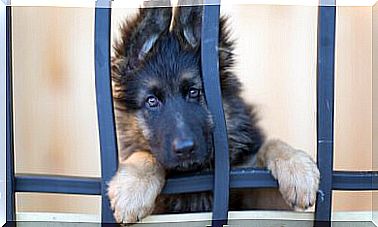Dog Ear Movements: What Do They Mean?

Dog ear movements are a form of communication they use. Not only do they convey how they feel, but they can also be accompanied by body language appropriate to the situation.
Since they can’t speak, dogs communicate using their entire body: eyes, tail and other parts. Of course, dogs’ ear movements are also part of communication. Discover the messages that are sent through them.
Dog ear movements and their communication
Dogs communicate thanks to their body posture and the movements they make. Really, they communicate all the time. Although they cannot articulate the words, the position of the tail, the movement when walking or the tilt of the head are communicative elements.
However, in order to fully understand what a dog is saying, it is necessary to take into account the context in which he finds himself. After all, many signs are the same, but with very different meanings, depending on the situation in which they appear.
This also happens with dog ear movements. It is not the same thing to show alertness while you are at home about to fall asleep and in the middle of the street playing with other dogs, for example. Also, we will have to keep in mind that there are many different types of ears. Therefore, not all allow the same movements.
To understand your dog’s communication and how he feels, you must observe a few things. The position of the body, but also its movement. Also, the context in which the movements take place and even the reaction of the dogs that are around your pet. But first, let’s talk about each move.
Ears forward: alert
The forward ears , whether erect, like a German shepherd, or drooping, like a beagle, indicate alertness and alertness. The dog is concentrating on capturing a sound that is coming from the front and, in addition, it is also directing its vision towards it.

It is possible to notice how this alert is being perceived in the rest of the animal’s body. He may be curious if his body is relaxed or his head is bowed. Also, it can indicate surprise if the rest of the body is not concentrated in the same place as the ears.
However, if the body is tense and looking at the source of the sound, the dog is in preoccupied and possibly ready to act. He may have recognized a playing dog or another dog he doesn’t like. In addition, he may even be detecting something that scares him and preparing himself in case he has to flee.
Relaxed ears: tranquility
When the ears are relaxed, the dog is more likely to be calm. When interacting with other dogs and with people, if the ears are in a comfortable and natural position, they are indicating that you are comfortable and that nothing bothers them.
However, there are many different types of ears. We must know the dog’s anatomy well to see if they are free of tension or if they are in any specific position. The shiba inu’s ears, for example, are always facing forward. Therefore, they can be mistaken for a warning sign.

Again, figuring out whether the ears are in this or the other position requires us to look at the dog in very different contexts. Fortunately, if the dog is relaxed, there are many other cues in his body that will give us clues to this.
Ears down: fear
When the dog throws its ears back, it wants to communicate something very different: it’s scared or it’s scared. The level of fear we feel should be defined by the position of the rest of the body and the context.
Fortunately, this is not one of your dog’s most common ear movements. No matter what kind of ears they have, they are mobile enough to face backwards. It’s very important to know when an animal is afraid and, luckily, it’s easy to spot.

Lowering your ears back can also be a sign of calm. There is something that is overwhelming the dog and he is asking us to back off or give him a moment to recover.
Different types of ears
Despite the importance of ears in canine communication, there are breeds and dogs that do not have them or whose ears have little mobility. For example, many potentially dangerous dogs have had their ears cut off. There are other breeds, like the Maltese, that keep their ears hidden under their fur.
These characteristics make it difficult for these animals to communicate. This difficulty occurs not only with animals, but also with humans. When this happens, a dog is more likely to find it difficult to make friends or interact without misunderstandings with other dogs.
Fortunately, dogs who have this difficulty are aware of their limitations and often use other communication strategies. They have the rest of the body to communicate and they know how to take advantage of it.
Your dog’s ear movements are critical in their communication. However, there are so many different shaped ears that you have to know them well to identify all of their positions. Know your dog’s anatomy well to quickly understand what he means.









